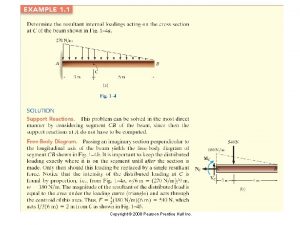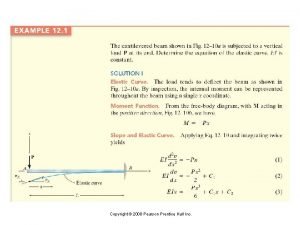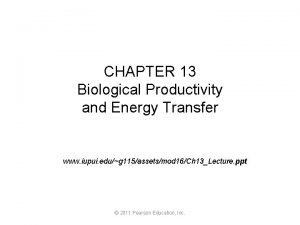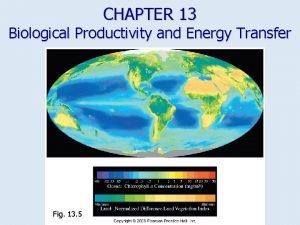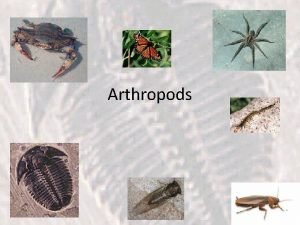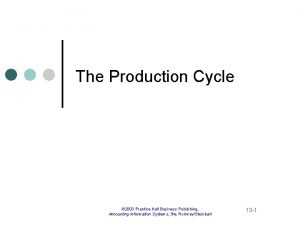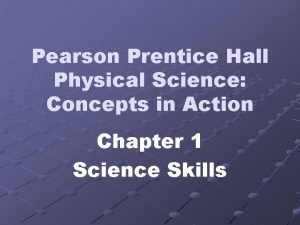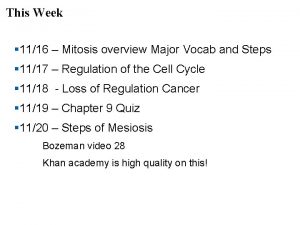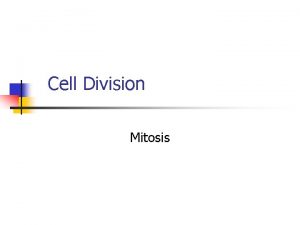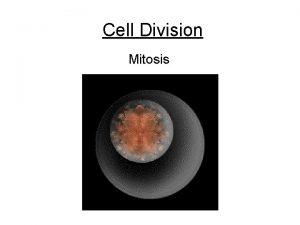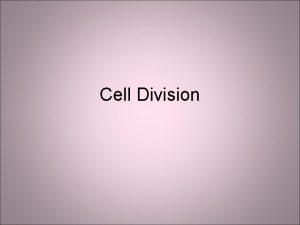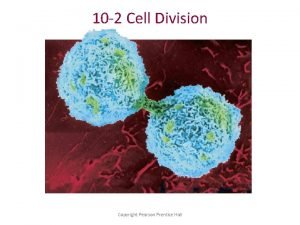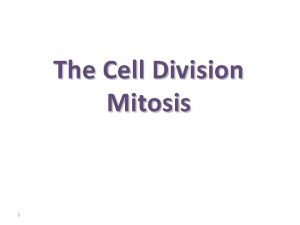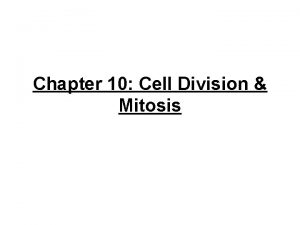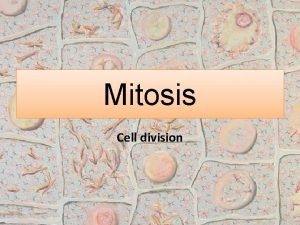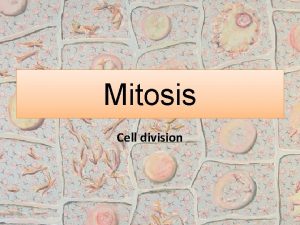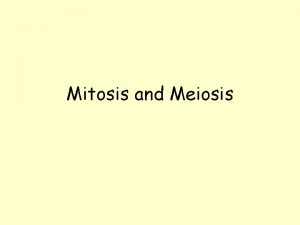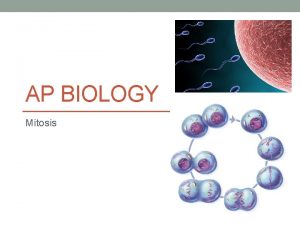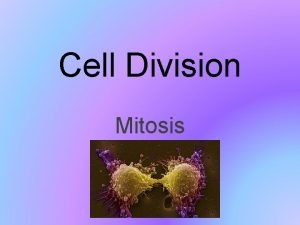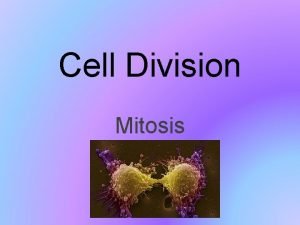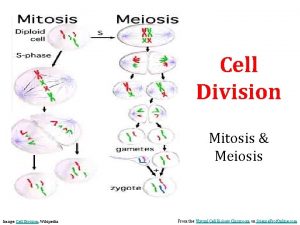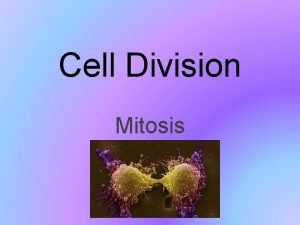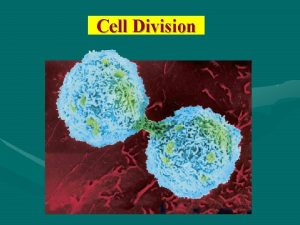Mitosis Cell Division Copyright Pearson Prentice Hall Why




































- Slides: 36

Mitosis- Cell Division Copyright Pearson Prentice Hall

Why do cells divide by Mitosis? • Growth &Repair • Reproduction of single celled organisms • Maintenance constant environment Amobea Reproducing

Cells dividing by Mitosis……. Skin • Identical to original cell • Same chromosome # • Identical chromosome makeup

The Cell Cycle • The sequence of growth and division of a cell. • 95% of cell cycle in interphase • 5% of cell cycle in mitosis


Events of the Cell Cycle Mitosis Copyright Pearson Prentice Hall

Interphase “Intermission” • Growth Stage 1 (G 1) – During G 1 phase • The cell increases in size • The cell synthesizes new proteins and organelles • Normal metabolic activity of the cell

Interphase “Intermission” • Synthesis Stage (S) During the S phase, • metabolic activity of the cell continues • chromosomes are replicated • DNA synthesis takes place Once a cell enters the S phase, it usually completes the rest of the cell cycle.

Interphase “Intermission” • Growth Stage 2 (G 2) – The G 2 Phase (Second Gap Phase) • metabolic activity of the cell, prepare for division • organelles and molecules required for cell division are produced Once G 2 is complete, the cell is ready to start the M phase—Mitosis

Interphase • “Intermission” • Normal metabolic activities • Major state • DNA= chromatin

Where is DNA located? 1. Nucleus 2. Chromosomes DNA

Duplicated Chromosome (Late Interphase): Sister Chromatids Centromere

Stages of Mitotic Cell Division • Prophase • Metaphase • Anaphase • Telophase • “ 1 st” • “middle” • “apart” • “far” or separate

Section 10 -2 Mitosis Spindle forming Prophase Chromosomes (paired Centromere Copyright Pearson Prentice Hall chromatids)

Prophase • Nuclear membrane disappears • Doubled DNA = condensed now called “chromosomes” • Spindle fibers

Spindle forming – Prophase • Prophase is the first and longest phase of mitosis. • The centrioles separate and take up positions on opposite sides of the nucleus. • Spindle fibres form Centromere Copyright Pearson Prentice Hall Chromosomes (paired chromatids)


Mitosis Centriole Spindle Centriole Metaphase Copyright Pearson Prentice Hall

Metaphase • Chromosomes line up mid- cell

Centriole – Metaphase • The second phase of mitosis is metaphase. • The chromosomes line up across the center of the cell. • Microtubules connect the centromere of each chromosome to the poles of the spindle. Spindle Copyright Pearson Prentice Hall


Mitosis Individual chromosomes Anaphase Copyright Pearson Prentice Hall

Anaphase • Chromosomes move to opposite poles at • Centrioles in animals • Spindle apparatus in plants

Spindle & spindle fibers: Pull apart the sister chromatids Spindle fibers

– Anaphase Individual • Anaphase is the third chromosomes phase of mitosis. • The sister chromatids separate into individual chromosomes. • The chromosomes continue to move until they have separated into two groups. Copyright Pearson Prentice Hall


Mitosis Nuclear envelope reforming Telophase Copyright Pearson Prentice Hall

Telophase • Cells divide • Cell plate or membranes form • Nucleus reappears


– Telophase Mitosis • Telophase is the fourth and final phase of mitosis. • Chromosomes gather at opposite ends of the cell and lose their distinct shape. • A new nuclear envelope forms around each cluster of chromosomes Copyright Pearson Prentice Hall

Cytokinesis Copyright Pearson Prentice Hall

Cytokinesis: cell’s cytoplasm divides & splits apart

Returns to Interphase • “Intermission” • Normal metabolic activities • Major state • DNA=chromatin

Plant versus Animal Mitosis Plant: • Cell wall • cell plate in telophase • Spindles Animal: • No cell wall • membrane cytokinesis • Centrioles

Animal Telophase Interphase

Text Reference • 2. 5 pages 40 -44 • Q #1 -5 page 44
 2005 pearson prentice hall inc
2005 pearson prentice hall inc 2011 pearson education inc
2011 pearson education inc 2011 pearson education inc
2011 pearson education inc Pearson education inc publishing as pearson prentice hall
Pearson education inc publishing as pearson prentice hall 2012 pearson education inc
2012 pearson education inc Copyright 2008
Copyright 2008 Pearson prentice hall
Pearson prentice hall 2008 pearson prentice hall inc
2008 pearson prentice hall inc Pearson prentice hall
Pearson prentice hall Ocean fisheries
Ocean fisheries Pearson prentice hall
Pearson prentice hall 2005 pearson prentice hall inc
2005 pearson prentice hall inc Pearson prentice hall
Pearson prentice hall Pearson education inc. publishing as prentice hall
Pearson education inc. publishing as prentice hall Pearson education 2012
Pearson education 2012 2011 pearson education inc
2011 pearson education inc 2011 pearson education inc
2011 pearson education inc Pearson education 2010
Pearson education 2010 Pearson education inc. publishing as prentice hall
Pearson education inc. publishing as prentice hall Mitosis meiosis
Mitosis meiosis Two cells are produced
Two cells are produced Mitosis
Mitosis Prentice hall inc
Prentice hall inc Prentice hall careers
Prentice hall careers Prentice hall america pathways to the present
Prentice hall america pathways to the present Prentice hall business publishing
Prentice hall business publishing Prentice hall african american history
Prentice hall african american history Pearson physical science concepts in action
Pearson physical science concepts in action Prentice hall business publishing
Prentice hall business publishing Chapter 4 job costing
Chapter 4 job costing Hey bye bye
Hey bye bye Section 10-2 cell division
Section 10-2 cell division Cell cycle and cell division
Cell cycle and cell division Cell cycle and cell division
Cell cycle and cell division Interphase of cell cycle
Interphase of cell cycle Cleavage furrow
Cleavage furrow Pearson education limited 2017
Pearson education limited 2017






